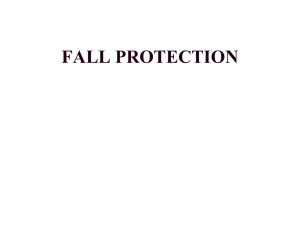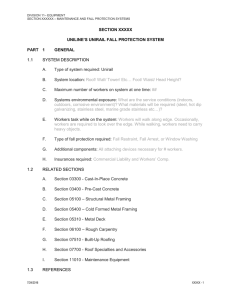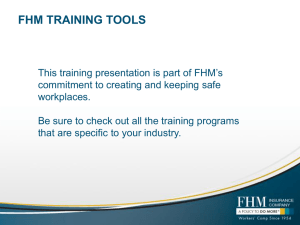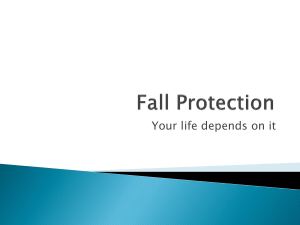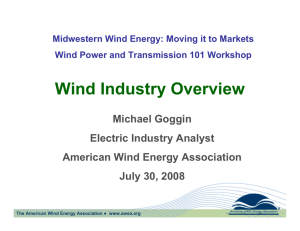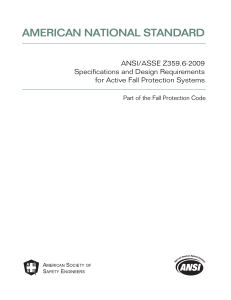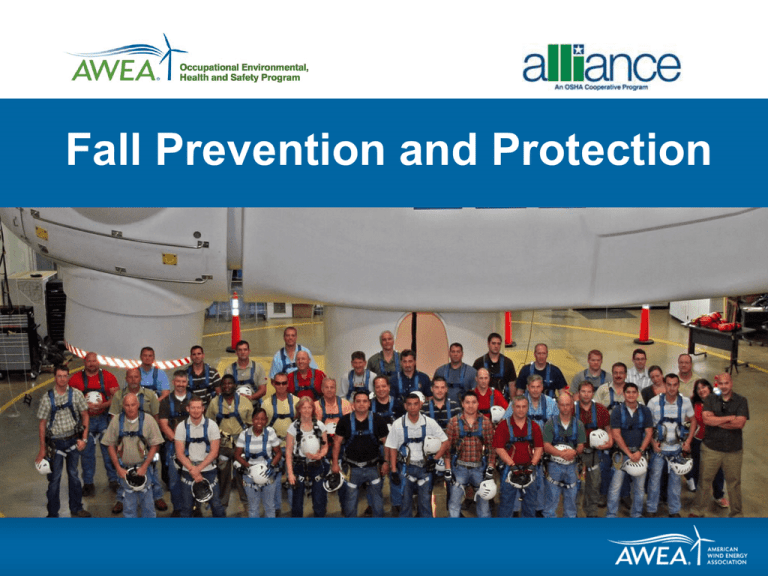
Fall Prevention and Protection
Disclaimer and Copyright
Through the OSHA and AWEA Alliance, AWEA developed this training module for informational purposes only. It does
not necessarily reflect the official views of OSHA or the U.S. Department of Labor. 7/13
© 2013 American Wind Energy Association. All rights reserved. You may download, reproduce and print this Fall
Prevention and Protection training module, and any portion hereof (the “Document”) for internal use only (which use
may include internal use by employees of your company), and, by downloading or accessing the Document, you agree:
(i) that you shall not sell or otherwise engage in any distribution of this Document; (ii) that you shall not make any
alterations, modifications, deletions or other changes to this Document without the express written consent of American
Wind Energy Association (“AWEA”); and (iii) to indemnify and hold AWEA harmless for any loss or damage, including
reasonable attorney's fees, that the AWEA may incur, directly or indirectly, as a result of your use of this Document.
AWEA assumes no liability for reliance on the contents of this document. AWEA is providing this document for
reference only in furtherance of AWEA’s nonprofit and tax-exempt mission. AWEA makes no representation or warranty
about the information contained in this document, including, without limitation, the suitability of the information
contained in this document for any purpose. It is offered only as general guidance and does not constitute legal,
medical, or professional advice. This document is not intended to, nor does it, include information regarding safe
operations and maintenance practices. Any recommended practices, guidance, or standards contained in this
document should be considered on a case by case basis and used in accordance with your company's internal safety
and other operating requirements as well as all applicable laws, regulations and recommended practices addressing
safety and regulatory compliance (such as OSHA and ANSI requirements). You should consider seeking legal or
professional advice on all matters concerning safety and regulatory compliance.
Lesson Overview
Purpose: To provide guidance for
• Understanding various fall hazards
at a Wind Turbine Generator
• Training employees on how to
protect themselves for fall
hazards.
• Correctly applying fall protection
equipment.
• Understanding regulatory
requirements.
Lesson Overview
Objectives
• Understand the many
applications for fall protection
• Be able to apply specific OSHA
Regulations
• Review Best Industry Practices
for Safe Access and Rescue
• Appreciate the consequences of
fall related injuries
Common Fall Hazards
in the Wind Energy Industry
• Struck by falling objects inside the towers
and outside near the base of the towers
• Falls that happen…
• from fixed ladders
• through platform hatchways
• inside the nacelle on uneven surfaces
• off the top of the nacelle and hub
• while moving to the hub and back
• into the hub enclosure
Consequences when falls
occur…
•
•
•
•
Serious injuries or possibly death
Difficulty getting to the fallen worker
Long lowering distances to get the victim
to safety
Limited resources to care for the victim…
Only work partners are immediately
available
Rescue assistance is typically at a
distance
Medical responders are frequently
unfamiliar with techniques for rescuing at
extreme heights
Human Factors
that have contributed to Injuries and Deaths in the
Wind Energy Industry
•
•
•
•
•
Lack of awareness (or failure to report) that problems
or hazards exist
Inadequate training on hazard recognition and
effective control methods
Failure of employers to provide sufficient or proper
safety equipment
Failure to train employees to correctly use all required
safety equipment.
Failure to ensure employees correctly use all required
safety equipment.
OSHA Requirements
• 29 CFR 1910 Subpart D – Walking Working Surfaces
• 29 CFR 1910 Subpart I – Personal Protective Equipment
• 29 CFR 1910.269(g) – Fall Protection for Power Generation Industry
• 29 CFR 1926 Subpart E – Personal Protective and Life Saving Equipment
• 29 CFR 1926 Subpart M – Fall Protection
Walking Working Surfaces
• Fall protection or
guarding is required
while working at 4’ or
higher if a fall hazard is
present
• Every hatchway or floor
opening must be
protected
• 1910.27 - Fixed
Ladders
• 1926.1053 - Ladders
Personal Protective Equipment
• §1910.132 Subpart I
• Hazard Assessment and Equipment
selection must be performed and
documented by each employer
whose workers are exposed.
• Employers must ensure that each
affected employee understand how
to use the specified PPE and be
properly fitted for the equipment they
are required to use.
• Employers must ensure employees
properly use and maintain PPE.
PPE Training Essentials
Per OSHA 29 CFR1910.132
Each employee shall demonstrate an understanding of the specified
training …and the ability to use PPE properly, before being allowed to
perform work requiring use of PPE.
This includes:
•when PPE/fall protection is
necessary
•what PPE/system is
necessary
•how to properly put on, take
off, adjust and wear PPE
•limitations of PPE/the system
•proper care, maintenance,
useful life and disposal of the
PPE
PPE Training Essentials
When the employer has reason to believe that any affected
employee who has already been trained does not have the
understanding and skill required. The employer shall retrain all
affected employees.
Retraining may also include:
• Workplace changes that
render previous training
obsolete
• Changes in type of PPE
• Inadequacies demonstrated
by the employee’s
performance
Fall Protection PPE Types
• Personal Fall Arrest Systems – system used to arrest
an employee in a fall from a working level. Consists of
an anchorage, connectors and a body harness.
• Positioning Device Systems – body belt or harness
system rigged to allow an employee to be supported
on an elevated vertical surface, such as a wall, and
work with both hands free while leaning.
Personal Fall Arrest Systems
Components:
•
•
Body Harnesses
–
Thigh strap
–
Chest straps
–
Shoulder strap
–
Adjusting buckles
–
D-ring(s)
Connecting Devices
–
Lanyards with shock absorbers
–
Retractable lanyards
–
Climbing devices
–
Work positioning devices
Personal Fall Arrest Systems
• Although applicable directly to Construction under
1926.502, paragraph (d) lists the requirements and
expectations for personal fall arrest systems including:
•
•
•
Design of system components
System performance criteria
Care and use of personal fall arrest systems
ANSI Z359 Fall Protection Code
The American National Standards Institute first published specifications
for Personal Fall Arrest Systems, Subsystems and Components” in 1992 as
a non regulatory consensus standard and revised them to their current form
beginning in 2007.
• The purpose of ANSI Z359 was to address the variety of
equipment being developed in the rapidly growing field of Fall
Protection.
• Z359 is an umbrella for a series of eight published fall
protection-related Standards and 9 additional proposed
standards currently being developed.
Five additional Standards were
approved as of November 24, 2007:
•
•
•
•
•
ANSI Z359.0 – Definitions and Nomenclature Used for Fall Protection
and Fall Arrest
ANSI Z359.1 – Safety Requirements for Personal Fall Arrest Systems,
Subsystems and Components
ANSI Z359.2 – Minimum Requirements for a Comprehensive Managed
Fall Protection Program
ANSI Z359.3 – Safety Requirements for Positioning and Travel Restraint
Systems
ANSI Z359.4 – Safety Requirements for Assisted Rescue and SelfRescue Systems, Subsystems and Components
An additional three Standards were
approved November 16, 2009:
•
•
•
ANSI Z359.6 – Specifications and
Design Requirements for Active Fall
Protection Systems
ANSI Z359.12 – Connecting
Components for Personal Fall Arrest
Systems
ANSI Z359.13 – Personal Energy
Absorbers and Energy Absorbing
Lanyards
General Duty Clause
In the absence of specific regulatory compliance requirements,
OSHA will apply Section 5(a)(1) The General Duty
Clause:
“Each employer shall furnish to each of his employees employment and place of
employment which are free from recognized hazards that are causing or likely
to cause death or serious physical harm…”
Controlling Falling Objects
Be aware of people working beneath you.
Clear the area below due to the great velocity
that can be generated from a dropped tool or
other item. To additionally assure safety…
• Tether your tools
• Cover any opening that materials
or parts could drop through
• Helmet/hardhat protection and
safety glasses must be worn
when personnel are overhead
Safe Ladder Climbing Practices
• Know your ladder safety system by practicing with it at safe heights
before climbing long distances.
• Use three points of contact with the ladder at all times
• Do not carry anything in your hands or in a way that your climbing could
be affected
– Instead, use a hoisting bag with a secure cover, a rated hauling rope, or an elevator or
installed lifting device
Safe Ladder Climbing Practices
• If stopping to work or rest, tie off with additional fall
protection to the beam of the ladder above you.
• NEVER hang from the ladder safety system as
your sole support.
• A good rule is allowing only one climber per ladder section
between platforms
• Step off the ladder and securely onto the platform before
disconnecting your ladder safety system
Hatches
• Once you reach the platform, close the hatchway cover (if so
equipped)
• If the hatchway remains open for the next climber or for hauling work,
tie off with your lanyard to an anchor point or part of the turbine
structure
• A good rule is to shout out “hatch open” and “hatch closed” to notify
other climbers of your activity and position above or below them
• If you hear a warning or noise that indicates something has been
dropped - COVER UP to minimize the chances of being hit
DO NOT LOOK UP TO SEE WHAT IS FALLING!
Personal Fall Arrest Systems
PFAS consist of:
•
An anchor point
•
A means of connecting the climber
to the anchor
•
A full body harness
Anchor Points
Two Types:
• Rated (Engineered)
• Structural Attachment
Rated Anchor Point:
•
•
•
•
Rated Anchors commonly have a
5000 lb. static capacity per employee attached
OR: Is designed, installed and used as part of a
system that maintains a safety factor of at least
two and is under the supervision of a qualified
person.
Should be labeled and or color coded
Only one climber per rated anchor point
– (Unless labeled otherwise)
•
DO NOT USE The Anchor point it if
damaged, corroded or compromised in
any way
Structural Anchor Points
•
•
•
Tie off only to structure you can trust to be a
minimum 5000 pound static capacity
One climber per anchor point
Created on structural steel from fall rated webbed
straps, slings, ropes, and connectors (snap hooks or
carabineers)
•
•
DO NOT USE if the strap, sling or rope is
damaged, or the connecting
devices are defective in any way
A qualified person shall determine appropriate
anchorage points.
PFAS
When stopping a fall, a PFAS must:
• Limit the impact to less than 1800 pounds of arresting force on the
body
• Prevent a person from contacting a lower level
• Bring the person to a complete stop and limit the maximum
deceleration distance of a shock absorber to 3.5 additional feet
• Have the strength to withstand at least twice the potential impact
force of a worker falling the full 6 foot length of their protective
connection lanyard (the maximum permitted PFAS fall distance)
Positioning Device Systems
These allow workers to do hands-free work from vertical
ladders or the tower/turbine structure:
• Positioning devices are not a fall arrest system.
Additional tie off must be used for personal fall
protection
• Must limit free fall to no more than 2 feet
• The anchorage point must be capable of withstanding
twice the potential impact of a worker’s fall or 3000
pounds whichever is greater.
Inspection
Before you climb – EVERY TIME:
• HARNESS – Cuts, tears, chemical stains, heat damage or
burns, torn stitching, extreme fading, lack of labeling,
excessive age
Check all D ring(s) and connecting hardware for damage, such as
stretching, narrowing, bending, cracks, etc.
Make sure the fall indicator is not deployed
• LANYARD(s) – Same checks as for harnesses
Snap hook connectors show no damage and operate correctly and
also need to be inspected for throat damage and damage to the
keeper
Always follow the Manufacturer’s Recommended Inspection
Procedure
Snap hooks must be of a locking type.
Inspection
Before you climb – EVERY TIME
• Ladder Safety Device:
Condition of the steel cable
Appearance and mechanical action of
the cable grab device
The device is properly oriented on the
cable
Smooth non-binding passage of the
grab device over the cable
Device properly engages on the cable
when quickly loaded
Measuring Total Fall Distance
Fall Arrest Equipment:
•
6 foot lanyard with shock absorbing lanyard measuring 3.5 feet fully elongated
4.0 Ft.
6.0 Ft. Free Fall
3.5 Ft. Shock Absorption
(9.5 Ft. Lanyard Fall Distance)
15.5 Ft. Minimum Clearance
6.0 Ft. Height
(D-ring to worker’s feet)
Add another 2 feet as a safety margin to allow for harness stretch
Projecting obstructions may affect the Total Fall Distance.
Actual distance from D-ring to workers’ feet may vary.
Swing Falls
When moving vertically and/or
horizontally away from an anchor
point, the climber must consider both
the mechanics and consequences of
a swing fall.
Has the best anchor been chosen for
the work to be completed?
• In a swing fall, sufficient force
to deploy shock absorbers in
the fall system may not occur
• The impact against surfaces
can result in fractures,
lacerations
and internal bleeding.
• These injuries can complicate
the already difficult job of
rescuing the fallen worker
Best Practices for Tying Off
•
Pick an Anchor point that will not
fail
•
Tie off directly overhead whenever
possible
•
Calculate the fall distance and set
your protection to avoid hitting
lower levels
•
Maintain your stability and footing
at all times
Always use caution …
Climb as if you had no fall
protection to save you
Suspension Trauma
After a fall, if a person is stranded in their harness the weight
of their body on the leg straps cuts off blood flow returning to
the torso. Blood pools in the legs severely limiting flow to their
upper body and head.
• Unconsciousness overcomes the victim followed shortly after by
respiratory arrest in as little as 10 -15 minutes after suspension
begins
• Once the victim is lowered to the ground and tension is released, a
large volume of poorly oxygenated blood will flow back to the heart,
lungs and brain from the legs.
• This complicates their rescue, compromises resuscitation efforts
and ultimately threatens their survival...
• Detailed FIRST AID TRAINING should be provided to
anyone who may have to treat a victim of Suspension
Trauma
Suspension Trauma
•
Uninjured climbers can quickly deploy support straps or
use their tensioned positioning lanyard beneath their feet
to lessen harness pressure and activate leg muscles,
effectively limiting or delaying the effects of suspension
trauma
•
Even with this emergency support, a plan to promptly
reach the victim and get them safely down for medical
care must be in place to have the best chance for a
successful rescue
Safe Access and Rescue Training
It is very common for Wind Energy
facilities to require their employees and
contractors to complete competency
training in:
• The safe use of all required fall protection
equipment
• The ability to perform
rescue of injured personnel
• The ability to make a rapid emergency
evacuation from a tower, turbine nacelle or
hub
• Recertification training is often required
every one to two years
Rescue Considerations
• Preplan rescues and provide training so that everyone is familiar
with how to carry out a rescue, what equipment is needed and how
to contact municipal responders and get them to the turbine site
• Rescues are high intensity and high stakes. Be prepared by
practicing at least twice a year with your equipment and personnel
to be ready if an emergency occurs
Conclusions
•
•
•
•
•
Know the rules - OSHA’s and your worksite
Understand how to use your equipment and inspect it
before each use
Watch for hazards and apply control measures to
eliminate your exposure to falls and other dangers
Expect your partner(s) to work as professionally as
you do. Set them straight if they jeopardize their
safety or yours
Know the rescue plan and how to respond if an
emergency occurs



